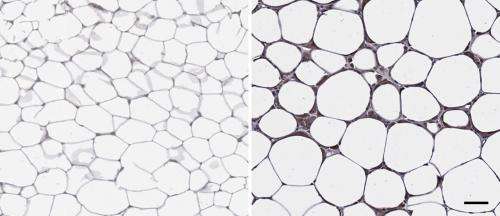White blood cell enzyme contributes to inflammation and obesity

Many recent studies have suggested that obesity is associated with chronic inflammation in fat tissues. Researchers at Sanford-Burnham Medical Research Institute (Sanford-Burnham) have discovered that an imbalance between an enzyme called neutrophil elastase and its inhibitor causes inflammation, obesity, insulin resistance, and fatty liver disease. This enzyme is produced by white blood cells called neutrophils, which play an important role in the body's immune defense against bacteria. The researchers found that obese humans and mice have increased neutrophil elastase activity and decreased levels of α1-antitrypsin, a protein that inhibits the elastase. When the team reversed this imbalance in a mouse model and fed them a high-fat diet, the mice were resistant to body weight gain, insulin resistance (a precursor to type 2 diabetes), and fatty liver disease.
Their study appears April 2 in Cell Metabolism.
"The imbalance between neutrophil elastase and its inhibitor, α1-antitrypsin, is likely an important contributing factor in the development of obesity, inflammation, and other health problems. Shifting this balance—by either reducing one or increasing the other—could provide a new therapeutic approach to preventing and treating obesity and several obesity-related conditions," said Zhen Jiang, Ph.D., assistant professor in Sanford-Burnham's Diabetes and Obesity Research Center at Lake Nona, Orlando and senior author of the study.
What happens when you reduce neutrophil elastase levels
This study began when Jiang and his team noticed that neutrophil elastase levels are particularly high and α1-antitrypsin levels are low in a mouse model of obesity. Then they saw the same thing in blood samples from human male volunteers.
To further probe this curious neutrophil elastase-obesity relationship, the researcher turned once again to mouse models. They found that mice completely lacking the neutrophil elastase enzyme don't get as fat as normal mice, even when fed a high-fat diet. Those mice were also protected against inflammation, insulin resistance, and fatty liver. The same was true in a mouse model genetically modified to produce human α1-antitrypsin, which inhibits neutrophil elastase.
Normal mice on a high-fat diet were also protected against inflammation, insulin resistance, and fatty liver when they were given a chemical compound that inhibits neutrophil elastase. This finding helps validate the team's conclusions about neutrophil elastase's role in inflammation and metabolism and also suggests that a medicinal drug could someday be developed to target this enzyme.
Mechanism: how neutrophil elastase influences inflammation and metabolism
How do high neutrophil elastase levels increase inflammation and cause weight gain and other metabolic problems?
Jiang and his team began connecting the mechanistic dots. They discovered that neutrophil elastase-deficient mice have increased levels of several factors, including adiponectin, AMPK, and fatty acid oxidation. These are known for their roles in increasing energy expenditure, thus helping the body burn excess fat.
















